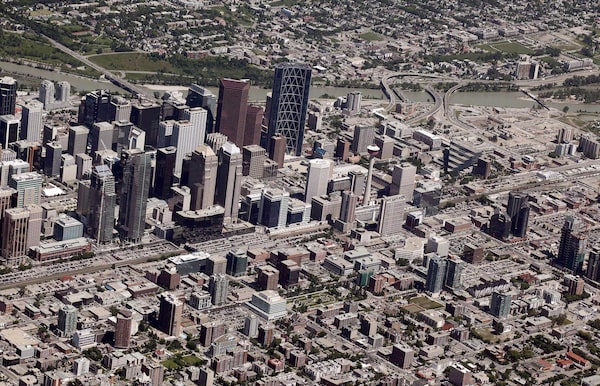
The downtown core is seen from the air in Calgary on July 11, 2013.Jeff McIntosh/The Canadian Press
Vacancies in Calgary’s downtown office towers have risen to record levels and there’s no landlord relief in sight with almost one in three offices sitting empty and sublets accounting for a quarter of available spaces on the market.
The city’s glut of empty office space has previously been linked to overbuilding but two commercial real estate reports released this past week show that downtown vacancy rates in Canada’s oil and gas capital are the highest in the country and growing – despite no major new towers opening in the past two years.
Vacancies are likely to go even higher, both reports note, driven by short-term factors including layoffs resulting from the takeover of Husky Energy Inc. by Cenovus Energy Inc. and longer-term job losses from cost-cutting and mergers in the oil and gas sector.
In its report released Thursday, real estate firm CBRE says the equivalent of four CFL football fields in downtown office space was emptied in the last quarter of 2020.
The net reduction of 355,000 square feet (32,000 square metres) took the vacancy rate to a record high of 29.5 per cent compared with 27.2 per cent in the fourth quarter of 2019.
“The negative absorption is due to the oil patch, not COVID-19,” said Greg Kwong, Calgary-based regional managing director for CBRE.
“People may not be going back to work because of the lockdowns but these companies still have leases in place and have to pay the rent. It’s not considered vacated space.”
CBRE found that 23.7 per cent of the available downtown office space in Calgary is being sublet by the lease holder.
In a separate report using different calculation methods, Avison Young pegged the downtown office vacancy rate at a record 26.9 per cent in the fourth quarter, up from 24.2 per cent in the year-earlier period.
Under an optimistic scenario, Avison Young predicts the vacancy rate will rise to 28.6 per cent by the end of 2023; in its pessimistic forecast, it foresees a rate of 32.9 per cent.
The merger of Cenovus and Husky offices in 2021 is projected to result in between 36,000 and 54,000 square metres of downtown space being vacated later this year, said Todd Throndson, managing director for Avison Young’s Calgary office. That’s around one per cent of the total inventory of 4.16 million square metres.
“We have a very difficult marketplace and there’s no quick solutions to solving that problem,” he said. “The next 12 to 24 months are going to be a challenging time for there to be any growth in our marketplace.”
Cenovus and Husky have said their merger will result in a reduction of between 20 and 25 per cent of the 8,600 combined employees and contractors – potentially more than 2,000 workers.
The two companies have about 300,000 square metres of lease commitments in Calgary, with some of it already being sublet to other tenants, said Cenovus spokesman Reg Curren. More space is expected to be sublet going forward, he said, declining to give specifics.
“Once COVID-19 restrictions are lifted and we determine our plan to return to the workplace, Brookfield Place will be the head office of the combined company,” he said, referring to the 56-storey glass and steel tower opened in 2017 that Cenovus calls home.
Husky’s head office is a few blocks west in the much older Western Canadian Place.
It’s not hard to find other Calgary companies reducing staff and their need for office space.
Suncor Energy Inc. announced in October it would reduce total staff by 10 to 15 per cent over 18 months, cutting as many as 1,930 jobs. Those cuts will be offset by the relocation of its Petro-Canada head office and most of its 700 jobs from Ontario to Calgary.
Imperial Oil Ltd. announced in November it would lay off 200 staff.
Meanwhile, office space held by Equinor Canada at Jamieson Place in downtown Calgary is on the sublet market after the Norwegian oil company decided to consolidate its Canadian operations in St. John’s, N.L.
Lower staff counts are also expected with the close of a handful of smaller oil and gas producer corporate mergers announced late last year.
Calgary’s office buildings have lost an overall 13 per cent of value, about $2.3 billion, over the past year due to higher vacancy rates and lower rents, the city said Thursday as it issued its 2021 property assessment notices.
Declines in recent years have pushed more of the municipal tax burden to residential and other business ratepayers.
Economic Development Calgary is using the city’s abundance of discounted office space as a “huge selling feature” in attracting Calgary employers in new sectors like technology and renewable energy, said CEO Mary Moran, but she concedes those new tenants haven’t replaced the oil and gas losses.
“I think, long-term, we know that the energy industry is not going to be the job creator,” she said. “It’s a jobless recovery in oil and gas.”
Your time is valuable. Have the Top Business Headlines newsletter conveniently delivered to your inbox in the morning or evening. Sign up today.